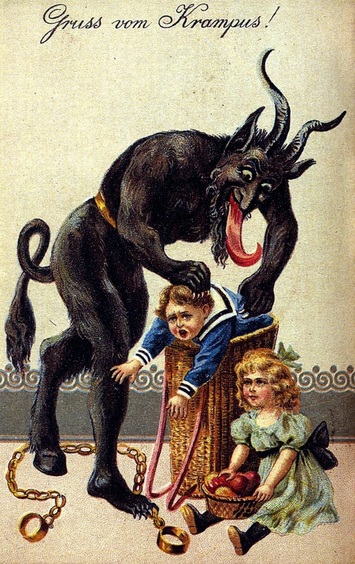This week, in many parts of Germany and Bavaria, people celebrate the "Krampusnacht", which is a throwback to a pre-Christian tradition, featuring a scary clawed incubus who hangs around with Santa Claus.
The Krampus is a beast-like creature from the folklore of Alpine countries thought to punish children during the Yule season who had misbehaved, in contrast with Saint Nicholas, who rewards well-behaved ones with gifts. Krampus is said to capture particularly naughty children in his sack and carry them away to his lair. A Krampus costume also includes sheepskin, horns, and a switch that the incubus uses to swat children and unsuspecting young ladies. There's been a resurgence in interest in Krampus over the past century or so, but it seems as though the custom goes back hundreds of years. The creature has roots in Germanic folklore; however, its influence has spread far beyond German borders.
Traditionally young men dress up as the Krampus in Austria, southern Bavaria, South Tyrol, northern Friuli, Hungary, Slovenia, the Czech Republic, the Slovak Republic and Croatia during the first week of December, particularly on the evening of 5 December (the eve of Saint Nicholas day on many church calendars), and roam the streets frightening children with rusty chains and bells. Krampus is featured on holiday greeting cards called "Krampuskarten". There are many names for Krampus, as well as many regional variations in portrayal and celebration.
The history of the Krampus figure stretches back to pre-Christian Germanic traditions. He is sometimes said to be the son of Hel, from Norse mythology. He also shares characteristics, including goat-like ears, legs, feet, with the satyrs and fauns of Greek mythology. The early Catholic Church discouraged celebrations based around the wild goat-like creatures, and during the Inquisition efforts were made to stamp them out. But Krampus figures persisted, and by the 17th century Krampus had been incorporated into Christian winter celebrations by pairing them with St. Nicholas. Countries of the former Habsburg empire have largely borrowed the tradition of Krampus accompanying St.Nicholas on 5 December from Austria. However, in the Czech Republic and Slovakia the mythological figure (called čert) evolved from the Slavic demon chort and although nearly the same in appearance, it comes from a tradition distinct from that of Alpine nations.
The Krampus is a beast-like creature from the folklore of Alpine countries thought to punish children during the Yule season who had misbehaved, in contrast with Saint Nicholas, who rewards well-behaved ones with gifts. Krampus is said to capture particularly naughty children in his sack and carry them away to his lair. A Krampus costume also includes sheepskin, horns, and a switch that the incubus uses to swat children and unsuspecting young ladies. There's been a resurgence in interest in Krampus over the past century or so, but it seems as though the custom goes back hundreds of years. The creature has roots in Germanic folklore; however, its influence has spread far beyond German borders.
Traditionally young men dress up as the Krampus in Austria, southern Bavaria, South Tyrol, northern Friuli, Hungary, Slovenia, the Czech Republic, the Slovak Republic and Croatia during the first week of December, particularly on the evening of 5 December (the eve of Saint Nicholas day on many church calendars), and roam the streets frightening children with rusty chains and bells. Krampus is featured on holiday greeting cards called "Krampuskarten". There are many names for Krampus, as well as many regional variations in portrayal and celebration.
The history of the Krampus figure stretches back to pre-Christian Germanic traditions. He is sometimes said to be the son of Hel, from Norse mythology. He also shares characteristics, including goat-like ears, legs, feet, with the satyrs and fauns of Greek mythology. The early Catholic Church discouraged celebrations based around the wild goat-like creatures, and during the Inquisition efforts were made to stamp them out. But Krampus figures persisted, and by the 17th century Krampus had been incorporated into Christian winter celebrations by pairing them with St. Nicholas. Countries of the former Habsburg empire have largely borrowed the tradition of Krampus accompanying St.Nicholas on 5 December from Austria. However, in the Czech Republic and Slovakia the mythological figure (called čert) evolved from the Slavic demon chort and although nearly the same in appearance, it comes from a tradition distinct from that of Alpine nations.
~Ally

 RSS Feed
RSS Feed